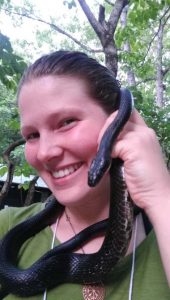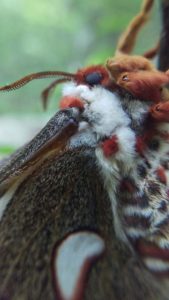 What outdoor adventure is worth pausing an Appalachian Trail thru-hike? Nature Camp!
What outdoor adventure is worth pausing an Appalachian Trail thru-hike? Nature Camp!
My mom, Theta, was a camper here as a kid, and I fell in love when she brought me to this community as an adult for volunteer work weekends and hikes. This year we finally had the chance to come to an adult session together, and it was definitely worth the train ticket.
This is everything education should be. Active, curiosity-driven learning supported by experienced, humble, and eager teachers who encourage everyone to cement their knowledge by teaching others what they know. Here I’m not the only one who wants to play with the black snake we found by the bunkhouse, and I can point at just about any plant, ask “what’s that?” and get both its Latin name and a tasty recipe.
There is magic in a place where teachers leading one class are students in the next, the attendee beside you has a PhD in astrophysics, and you can watch the artist’s passion for herpetology shine as she dives into the creek after a salamander. Opportunities to learn surround you, and the whole thing is tied together with an incredible sense of community and outstanding local food from the kitchen.
 I spent much of the weekend learning about salamanders with Nell Fredericksen, who presented The Unexpected Life Cycles of Amphibians and helped identify things we found digging through several creeks and ponds. We went on a field trip to Maple Flats, led by Reid Downer, which has several sinkhole ponds that hold water for several months. These vernal pools offer salamanders and frogs breeding pools for their eggs and larval stages, while excluding their fishy predators. There we found three larval Tiger salamanders, which have a tiny disjunct population just in this county separate from populations on the coast of Virginia. We also found hundreds of larval Seal salamanders in a night raid on Buttermilk Springs, and learned that these salamanders lose the external gills of the larvae but never grow lungs, instead breathing osmotically through their skin. These classes made quite an impact on me, and I’ve spent the rest of my summer on the Trail peering more closely into ponds and using the resources she gave us to identify the creatures I’ve found.
I spent much of the weekend learning about salamanders with Nell Fredericksen, who presented The Unexpected Life Cycles of Amphibians and helped identify things we found digging through several creeks and ponds. We went on a field trip to Maple Flats, led by Reid Downer, which has several sinkhole ponds that hold water for several months. These vernal pools offer salamanders and frogs breeding pools for their eggs and larval stages, while excluding their fishy predators. There we found three larval Tiger salamanders, which have a tiny disjunct population just in this county separate from populations on the coast of Virginia. We also found hundreds of larval Seal salamanders in a night raid on Buttermilk Springs, and learned that these salamanders lose the external gills of the larvae but never grow lungs, instead breathing osmotically through their skin. These classes made quite an impact on me, and I’ve spent the rest of my summer on the Trail peering more closely into ponds and using the resources she gave us to identify the creatures I’ve found.
I also took a class with Terry Richardson, who showed us how to make an inexpensive external macro lens for our smart phones. Other classes taught me about how plant communities interact, the effects of native and invasive plant species, and how areas react to wild and proscribed fires. It was quite a week. My advice to you? If Nature Camp calls, you should answer.
-Alexandra Miller
